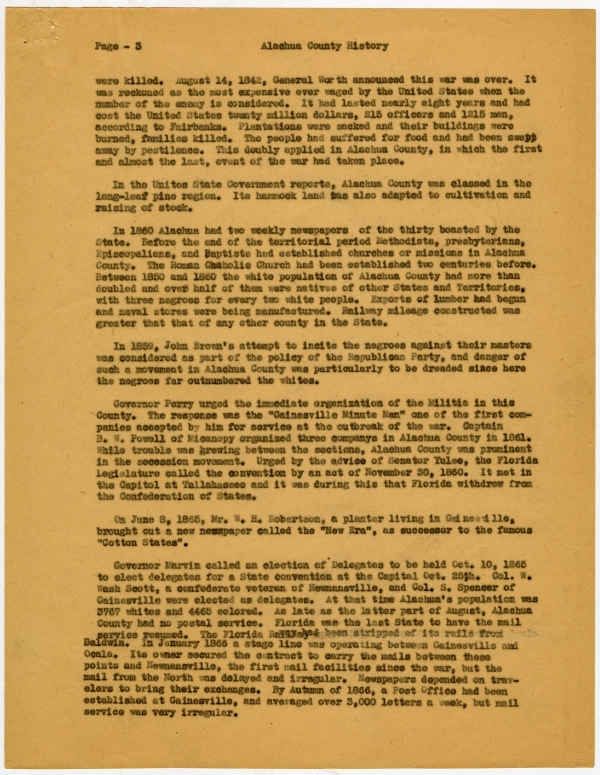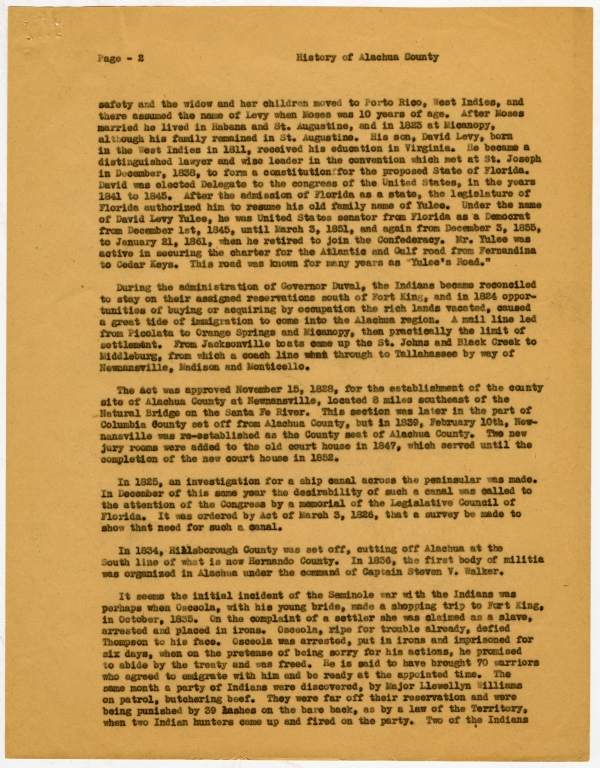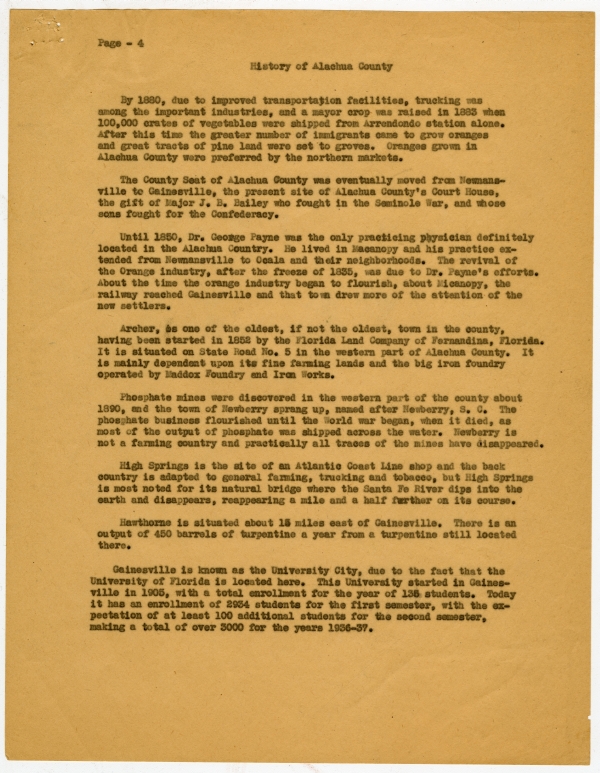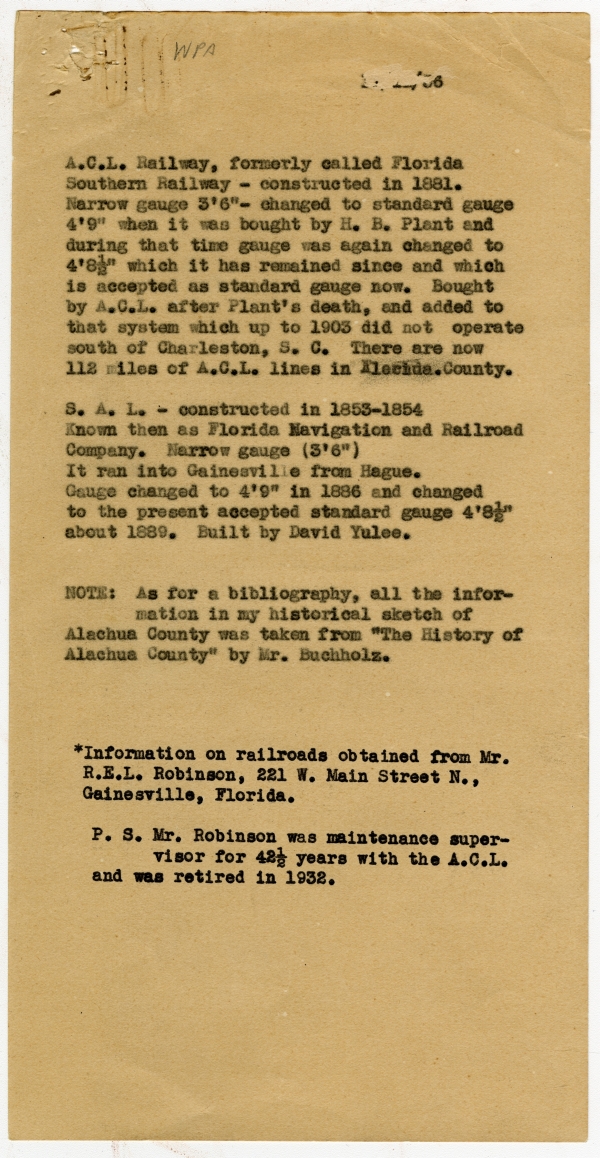Transcript
HISTORY OF ALACHUA COUNTY
Settlement of Alachua County by white people was first begun in 1820 by Horatio S. Dexter and Edward M. Wanton, Agents for Don Fernando de la Maza Arrendondo, and enterprising merchant of Havana. Don Peter Mitchell, William T. Hall and Pedro Mirandez were employed to engage people to settle on Arrendondo's land. They hired John Smith and Patrick Lannam as settlers. Smith, Lannam and Hall reached Alachua November 7, 1830, and immediately began clearing land and erecting dwellings one and one half miles east of Payne's Old Town. (On an old map this Indian town is marked as one and one half miles north of Micanopy, east of Fort Crane Head) The first settler who stayed on the land was Edward M. Wanton. He arrived in Alachua April 10, 1821, having moved from Picolata on the St. Johns, under contract with Arrendondo's agent Horation S. Dexter, to settle on the Alachua lands with the consent of the Indians.
Mr. Moses Elias Levy of St. Thomas, West Indies, had bought 36,000 acres of land on Alligator Creek, just south of Lake City, for which he paid $25,000. He traded this to [Arrendondo] & Son for a share in the Alachua Grant. He acquired 20,000 acres just north of Micanopy. He got Frederick S. Warberg of Hamburg, Germany to settle this. Mr. Warberg brought 22 people, including 15 slaves, and began the settlement of the Levy Grant. Although the original settlement of Smith & Lannam was on the property bought by Levy, it seems that they had abandoned their farm, and others who came had made a start elsewhere.
Don Francis P. Sanchez, a cattle man and planter on the Santa Fe, had the contract to deliver the necessary provisions to the [Arrendondo] store at Alachua during the years of 1820 to 1822. He hauled, in the two years, over $4,000 worth of corn and dry goods to the settlement. In 1822 the settlers cut a road to Picolata and some $4,000 worth of goods came in to the Levy settlement through other channels. Dr. William Simmons of St. Augustine, famous as one of the commissioners who selected Tallahassee as a site for the Capital, visited this section in 1822 and again in 1823. Between the times of these visits he found that the settlers had built a road with adequate bridges, wide enough for wheeled vehicles, through to Picolata 45 miles away, that they had established three settlements of which Levy's had some 30 people of whom 8 were white, worked five or six horses, three teams of oxen, with dwellings enough for those who were there, and besides the out house, stable, corn house and blacksmith shop, with a good crop of corn sufficient for his settlers for the year.
In the grant to Arrendondo it was agreed that he was to settle two hundred Spanish families during the period of four years. When the allotted time was up, he had but twenty homes established, but the company had made honest effort, as had Moses E. Levy, to fulfill their contract, as they were well able to prove to the satisfaction of the federal land office at Washington, at the time when the company incorporated its settlers and applied for title. At this time Moses Elias Levy was acquiring property on other parts of the territory. Along the St. Johns and on Tampa Bay he had secured great bodies of land suitable for development and ranks among the greatest empire builders of his day in Florida. Moses' father, a former prime minister of Morocco, became a fugitive upon a change of administration in that country. Escaping to Gibralter, his wife and children awaited him, but he died in Egypt. His Morrish name, Yulee, was dropped for reasons of
Page - 2
History of Alachua County
safety and the widow and her children moved to [Puerto] Rico, West Indies, and there assumed the name of Levy when Moses was 10 years of age. After Moses married he lived in [Havana] and At. Augustine, and in 1823 at Micanopy, although his family remained in St. Augustine. His son, David Levy, born in the West Indies in 1811, received his education in Virginia. He became a distinguished lawyer and wise leader in the convention which met at St. Joseph in December, 1838, to form a constitution for the proposed State of Florida. David was elected Delegate to the congress of the United States, in the years 1841 to 1845. After the admission of Florida as a state, the legislature of Florida authorized him to resume his old family name of Yulee. Under the name of David Levy Yulee, he was United States senator from Florida as a Democrat from December 1st, 1845, until March 3, 1851, and again from December 3, 1855, to January 21, 1861, when he retired to join the Confederacy. Mr. Yulee was active in securing the charter for the Atlantic and Gulf road from Fernandina to Cedar Keys. This road was known for many years as "Yulee's Road."
During the administration of Governor Duval, the Indians became reconciled to stay on their assigned reservations south of Fort King, and in 1824 opportunities of buying or acquiring by occupation the rich lands vacated, caused a great tide of immigration to come into the Alachua region. A mail line led from Picolata to Orange Springs and Micanopy, then practically the limit of settlement. From Jacksonville boats came up the St. Johns and Black Creek to Middleburg, from which a coach line went through to Tallahassee by way of Newnansville, Madison and Monticello.
The act was approved November 15, 1828, for the establishment of the county site of Alachua County at Newnansville, located 8 miles southeast of the Natural Bridge on the Santa Fe River. This section was later in the part of Columbia County set off from Alachua County, but in 1839, February 10th, Newnansville was re-established as the County seat of Alachua County. The new jury rooms were added to the old court house in 1847, which served until the completion of the new court house in 1852.
In 1825, an investigation for a ship canal across the peninsular was made. In December of this same year the desirability of such a canal was called to the attention of the Congress by a memorial of the Legislative Council of Florida. It was ordered by Act of March 3, 1826, that a survey be made to show that need for such a canal.
In 1834, Hillsborough County was set off, cutting off Alachua at the South line of what is now Hernando County. In 1836, the first body of militia was organized in Alachua under the command of Captain Steven V. Walker.
It seems the initial incident of the Seminole war with the Indians was perhaps when Osceola, with his young bride, made a shopping trip to Fort King, in October, 1835. On the complaint of a settler she was claimed as a slave, arrested and placed in irons. Osceola, ripe for trouble already, defied Thompson to his face. Osceola was arrested, put in irons and imprisoned for six days, when on the pretense of being sorry for his actions, he promised to abide by the treaty and was freed. He is said to have brought 70 warriors who agreed to emigrate with him and be ready at the appointed time. The same month a party of Indians were discovered, by Major Llewellyn Williams on patrol, butchering beef. They were far off their reservation and were being punished by 39 lashes on the bare back, as by a law of the Territory, when two Indian hunters came up and fired on the party. Two of the Indians
Page - 3
Alachua County History
were killed. August 14, 1842, General Worth announced this war was over. It was reckoned as the most expensive ever waged by the United States when the number of the enemy is considered. It had lasted nearly eight years and had cost the United States twenty million dollars, 215 officers and 1215 men, according to Fairbanks. Plantations were sacked and their buildings were burned, families killed. The people had suffered for food and had been swept away by pestilence. This doubly applied in Alachua County, in which the first and almost the last, event of the war had taken place.
In the [United States] Government reports, Alachua County was classed in the long-leaf pine region. Its hammock land was also adapted to cultivation and raising of stock.
In 1860 Alachua had two weekly newspapers of the thirty boasted by the State. Before the end of the territorial period Methodists, presbyterians, Episcopalians, and Baptists had established churches or missions in Alachua County. The Roman Catholic Church had been established two centuries before. Between 1850 and 1860 the white population of Alachua County had more than doubled and over half of them were natives of other States and Territories, with three negroes for every two white people. Exports of lumber had begun and naval stores were being manufactured. Railway mileage constructed was greater [than] that of any other county in the State.
In 1859, John Brown's attempt to incite the negroes against their masters was considered as part of the policy of the Republican Party, and danger of such a movement in Alachua County was particularly to be dreaded since here the negroes far outnumbered the whites.
Governor Perry urged the immediate organization of the Militia in this County. The response was the "Gainesville Minute Men" one of the first companies accepted by him for service at the outbreak of the war. Captain B. W. Powell of Micanopy organized three companys in Alachua County in 1861. While trouble was brewing between the sections, Alachua County was prominent in the secession movement. Urged by the advice of Senator Yulee, the Florida Legislature called the convention by an act of November 30, 1860. It met in the Capitol at Tallahassee and it was during this that Florida withdrew from the Confederation of States.
On June 8, 1865, Mr. W. H. Robertson, a planter living in Gainesville, brought out a new newspaper called the "New Era", as successor to the famous "Cotton States".
Governor Marvin called an election of Delegates to be held Oct. 10, 1865 to elect delegates for a State convention at the Capital Oct. 25th. Col. W. Wash Scott, a confederate veteran of Newnansville, and Col. S. Spencer of Gainesville were elected as delegates. At that time Alachua's population was 3767 whites and 4465 colored. As late as the latter part of August, Alachua County had no postal service. Florida was the last State to have the mail service returned. The Florida Railway had been stripped of its rails from Baldwin. In January 1866 a stage line was operating between Gainesville and Ocala. Its owner secured the contract to carry the mails between these points and Newnansville, the first mail facilities since the war, but the mail from the North was delayed and irregular. Newspapers depended on travelers to bring their exchanges. By Autumn of 1866, a Post Office had been established at Gainesville, and averaged over 3,000 letters a week, but mail service was very irregular.
Page - 4
History of Alachua County
By 1880, due to improved transportation facilities, trucking was among the important industries, and a [major] crop was raised in 1883 when 100,000 crates of vegetables were shipped from Arrendondo station alone. After this time the greater number of immigrants came to grow oranges and great tracts of pine land were set to groves. Oranges grown in Alachua County were preferred by northern markets.
The County Seat of Alachua County was eventually moved from Newnansville to Gainesville, the present site of Alachua County's Court House, the gift of Major J. B. Bailey who fought in the Seminole War, and whose sons fought for the Confederacy.
Until 1850, Dr. George Payne was the only practicing physician definitely located in the Alachua Country. He lived in [Micanopy] and his practice extended from Newnansville to Ocala and their neighborhoods. The revival of the Orange industry, after the freeze of 1835, was due to Dr. Payne's efforts. About the time the orange industry began to flourish, about Micanopy, the railway reached Gainesville and that town drew more of the attention of the new settlers.
Archer, is one of the oldest, if not the oldest, town in the county, having been started in 1852 by the Florida Land Company of Fernandina, Florida. It is situated on State Road No. 5 in the western part of Alachua County. It is mainly dependent upon its fine farming lands and the big iron foundry operated by Maddox Foundry and Iron Works.
Phosphate mines were discovered in the western part of the county about 1890, and the town of Newberry sprang up, named after Newberry, S. C. The phosphate business flourished until the World war began, when it died, as most of the output of phosphate was shipped across the water. Newberry is not a farming country and practically all traces of the mines have disappeared.
High Springs is the site of an Atlantic Coast Line shop and the back country is adapted to general farming, trucking and tobacco, but High Springs is most noted for its natural bridge where the Santa Fe River dips into the earth and disappears, reappearing a mile and a half further on its course.
Hawthorne is situated about 15 miles east of Gainesville. There is an output of 450 barrels of turpentine a year from a turpentine still located there.
Gainesville is known as the University City, due to the fact that the University of Florida is located here. This University started in Gainesville in 1905, with a total enrollment for the year of 135 students. Today it has an enrollment of 2934 students for the first semester, with the expectation of at least 100 additional students for the second semester, making a total of over 3000 for the years 1936-37.
WPA
A. C. L. Railway, formerly called Florida Southern Railway - constructed in 1881. Narrow gauge 3'6"- changed to standard gauge 4'9" when it was bought by H. B. Plant and during that time gauge was again changed to 4'8 1/2" which it has remained since and which is accepted as standard gauge now. Bought by A. C. L. after Plant's death, and added to that system which up to 1903 did not operate south of Charleston, S. C. There are now 112 miles of A. C. L. lines in [Alachua] County.
S. A. L. - constructed in 1853-1854 Known then as Florida Navigation and Railroad Company. Narrow gauge (3'6") It ran into Gainesville from Hague. Gauge changed to 4'9" in 1886 and changed to the present accepted standard gauge 4'8 1/2" about 1889. Built by David Yulee.
NOTE: As for a bibliography, all the information in my historical sketch of Alachua County was taken from "The History of Alachua County" by Mr. Buchholz.
*Information on railroads obtained from Mr. R. E. L. Robinson, 221 W. Main Street N., Gainesville, Florida.
P. S. Mr. Robinson was maintenance supervisor for 42 1/2 years with the A. C. L. and was retired in 1932.




 Listen: The World Program
Listen: The World Program


